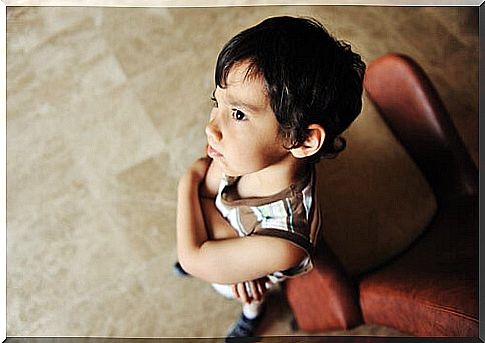The Symmetrical Child, A Disturbing Phenomenon

We are in a world in which children behave more and more like adults and adults like children. In this way, the phenomenon of the symmetrical child could be colloquially summarized. It is a theory developed by the Argentine psychologist Claudia Messing, author of the book How children feel and think today .
The symmetrical child phenomenon, which is also known as the mirror child theory, is based on Messing’s clinical findings. She highlights the fact that children are increasingly difficult to contain, much more troubled than before, and have fewer psychological resources to complete their individuation process. In turn, they repeat dysfunctional patterns of their parents, according to the author.
For this psychologist, the phenomenon of the symmetrical child has its roots in new parenting styles. In these, there is neither a coherent exercise of authority nor a clear definition of the maternal, paternal and filial roles. A kind of excessive democracy has been imposed, which blurs family hierarchies and in which everyone ends up seeing each other as peers, when they are not.

The characteristics of the symmetrical child
The main characteristic of the symmetrical child is that it is a very difficult person to contain. He believes he is right all the time, he believes he is totally sure of what he wants and he hates being set limits.
He gives little credit to adults, because he does not feel that they have something to contribute to him. They don’t see them as more knowledgeable, or more experienced, or anything else. To them, they are simply their equals.
This type of child also has a hard time maintaining relationships with other children. It is a basically conflictive and competitive relationship. They have a low capacity for empathy, because they feel that the world is as they see it and not in any other way.
Likewise, the symmetrical child has great difficulty in detaching himself from his parents when he reaches adulthood. It is not that he is too attached to them, but that he does not know how to structure an independent life project. His adaptability is low and for that reason he prefers to stay in the known.
The dimensions of the phenomenon
The psychologist Claudia Messing points out that the phenomenon of the symmetrical child encompasses four dimensions. The first is the massive mimicry or copy of the adult; the second, parity with the adult; the third, the fantasy of completeness, and the fourth, the lack of individuation. Let’s see what each one is about.
Mass mimicry or adult copying refers to that mirror effect that these children experience with their parents. They copy them on everything. Now why does this become a problem?
Because children have unlimited access to adult life and end up copying the traumas and difficulties of their parents as well. In turn, because this leads to the second dimension: parity with the adult.
When talking about parity with the adult, what is referred to is the idea that the adult does not have authority over the child, that he is an equal. Therefore, the child does not have that filter that there was before.
A few years ago, the little ones kept a certain distance from the adults and knew that they could not do everything like them, because they were children. Today that distance does not exist. That is why there is an almost total identification.

The fantasy of completeness and lack of individuation
From the above it follows that the child ends up thinking that he can do everything, as an adult would. They try to adopt the role of the father, giving advice and even orders around the house.
They also pretend to take the place of the teacher, telling him what to teach and how. However, sooner or later they collide with the reality that they do not have the tools to do so. This scares and confuses them.
What has been described in the previous paragraph is the fantasy of completeness. The child feels self-sufficient, even if it is not. You don’t think you really need to learn, or that you are in a growth process. That is why he is not receptive to the indications of his parents and teachers. This, in turn, prevents him from going through a process of real individuation, that is, an unfolding of his authentic being. He imitates, he is not.
According to Dr. Messing, this situation is overcome only if family roles are rebuilt. Parents and children are not equal and those who exercise authority come first.
This authority is not authoritarianism, but a validation of their condition as guides and generators of behavior patterns. The child is financially, emotionally and socially dependent on his parents. This gives them the authority to direct the family structure. And it is not negotiable.









